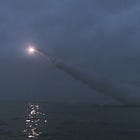Water Discharge From North Korea's Yongbyon Nuclear Reactor Warm, Indicating It's Reached Criticality
The light water reactor can produce plutonium in its irradiated fuel, which can be used to produce fuel for nuclear weapons.
VIENNA, AUSTRIA - The International Atomic Energy Agency (IAEA), which previously reported on November 22nd that North Korea's light water reactor (LWR) at its Yongbyon nuclear site was observed to have been active since mid-October, now says that they have observed warm water discharge from the LWR, which is indicative that the reactor has now reached criticality.
While the light water reactor could be used for electricity generation, the IAEA warned that like any nuclear reactor, the LWR can produce plutonium in its irradiated fuel, which can be used to produce fuel for nuclear weapons.
The findings come as North Korea fired a short-range ballistic missile on December 17th, as well as an intercontinental ballistic missile (ICBM) on December 18th which then landed in the Sea of Japan just outside of the Japanese Exclusive Economic Zone (EEZ) earlier this week.
After the launches, North Korea's state media released a statement on the launch that said, "The Central Military Commission of the Workers' Party of Korea (WPK) gave the order to take a powerful warning measure under the grave situation, in which the hostile forces' anti-DPRK [North Korean] military threat that has persisted for the whole of this year is getting evermore undisguised and dangerous even at this moment of year-end December".
"On December 15, the U.S. and the military gangsters of the Republic of Korea held a nuclear war confab called the second meeting of the Nuclear Consultative Group in Washington and openly revealed their intention to conduct large-scale joint drills under the simulated conditions of an actual war of nuclear retaliatory strike at the DPRK, again crying out for the end of its regime", the statement continued.
"Under the decision of the WPK Central Military Commission on neutralizing the enemies' intentional and premeditated confrontational military threats with our strong behavioral warning, a drill of launching ICBM Hwasongpho-18 was staged as an important military action to clearly show the DPRK's nuclear strategic forces' overwhelming counteraction will and matchless strength to the enemies," it continued.
"The drill was aimed to review the combat readiness of the DPRK's [North Korea's] nuclear war deterrence and confirm its mobility, combat capability and reliability."










